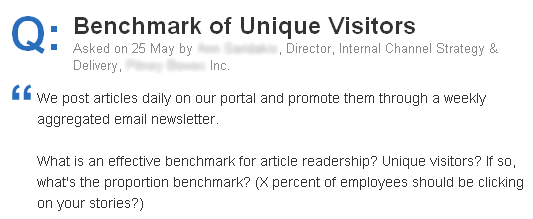I received this question this afternoon from an association site I belong to. Below is the answer I responded with on the association site but I want to make sure anyone can add additional thoughts to this topic which is why I am also posting it here (similar to the lemonade stand analogy below). How would you have answered the question?
Good question, we don’t have a set percentage to gauge success. My benchmark wouldn’t be a traditional benchmark. When news articles or internal announcements get more “hits” we assume it is due to what the article pertains to. We notice that content which isn’t particularly engaging doesn’t get many hits. Anything from C Level Management, or a major announcement tends to get higher viewership. Even every day news items may not pertain to everyone. Furthermore, it just may not interest them. It is one of those instances where “you can lead an employee to the news story but you can’t make them consume it”.
We may want 100% of our associates reading what we put out but we are finding that isn’t the case and we are looking to move to a subscription and “pushed” communications model. We are playing with a design that has a top portion of the page what has what is considered “pushed” news and a bottom section which contains what each associate has subscribed to. Our philosophy is if they have helped decide what they want to see, they will be more inclined to visit the site, or read the content in the email summary.
If you have the ability it would be great to show percent viewing the news story but also the number of comments and how well the story was rated. I’d personally be much more interested in that data as opposed to knowing an article was clicked or accessed. It would also be great to have analytics on how long they were on the page and site (time wise). If you have 1,000 employees and you are able to get all 1,000 to click a 5,000 word article but on average they only stay on that page for 10 seconds, I’d consider that an opportunity.
I’m trying to change our culture but I know it isn’t easy. Currently I would say we only focus on content consumption but I want to get us to where we also focus on opinions and ratings of the content. I’m trying to make it so we think of ourselves as a lemonade stand. We, the Communications Group push out lots of lemonade. If the lemonade doesn’t have enough sugar in it nobody will want to drink it. If we put our lemonade on the wrong side of town we make it too tough for them to find us so we opened several lemonade stands (one on our Intranet and one via email like yourself).
If we sell the lemonade and only focus on how much we sell, as opposed to what people think of it, we won’t grow our lemonade business. Sales and number of product sold is important but I’d take one customer who pays $1 for my lemonade and gives me feedback to 10 customers who each pay a dollar ($10 total) who drink my lemonade yet don’t give me feedback to improve my product long term. The lemonade stand that focuses on getting the most customers to their stand may be able to attract lots of customers, but the lemonade stand that focuses on what the customers think of their product will be the stand likely to stay open the longest…and make the most money. Not sure if that analogy works but it was fun to try.
It is also almost like a one sided conversation if we only focus on analytics. If I do all of the talking, and you aren’t allowed to talk back, how valuable is that for you and the organization? My benchmark would be anything that can show you are providing engaging content that inspires enterprise collaboration and knowledge sharing. For instance an article with 10 replies/comments that is rated highly is of more importance to me from a benchmarking perspective than one that is accessed more often. Great question, that is what I am thinking is the best benchmark but I’d imagine others may find other analytics more useful.
